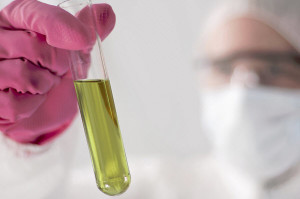New material could help convert fossil-fuels into hydrogen fuel
August 12, 2014Newly created material may be a boon for carbon capture and hydrogen production
Researchers from the University of Liverpool in the United Kingdom have devised a new way to capture carbon dioxide. The material could play a major part in helping society move away from fossil-fuels, embracing cleaner energy options, such as hydrogen. Carbon capture is becoming a relatively popular subject as more countries look for ways to mitigate the emissions that they are responsible for. Modern carbon capture methods are typically expensive and logistically difficult to manage, but this new material could help make carbon dioxide less environmentally dangerous than it is today.
Sponge-like material is able to absorb carbon dioxide efficiently
The material is comprised of plastic that is a relative to that used to make food containers. The sponge-like material is capable of absorbing carbon dioxide in an efficient manner and this material can be produce without great expense. The material is expected to be part of an emerging process called the “integrated gasification combined cycle.” This process involves converting fossil-fuels into hydrogen fuel.
Hydrogen fuel continues to grow in popularity throughout a wide range of industries
 Hydrogen has become a very popular form of alternative energy in recent years. While the fuel cells that use hydrogen to generate electricity are still quite expensive, many industries are beginning to use these energy systems to cut down on the emissions that they produce. Converting fossil-fuels and their byproducts into hydrogen could add more attraction to fuel cells. Currently, one of the major detractors of fuel cells, especially in terms of transportation, is the lack of an efficient method through which hydrogen can be produced.
Hydrogen has become a very popular form of alternative energy in recent years. While the fuel cells that use hydrogen to generate electricity are still quite expensive, many industries are beginning to use these energy systems to cut down on the emissions that they produce. Converting fossil-fuels and their byproducts into hydrogen could add more attraction to fuel cells. Currently, one of the major detractors of fuel cells, especially in terms of transportation, is the lack of an efficient method through which hydrogen can be produced.
New material may hold the key to making carbon capture a viable option for the improvement of the environment
Many countries have emissions regulations in place to police the release of carbon dioxide and other greenhouse gases into the environment. These regulations cannot stop emissions entirely, however, which is why carbon capture is beginning to receive more support. Carbon capture is still relatively new, but innovation in this field is coming at a rapid pace.

 With over 15 years of reporting hydrogen news, we are your premier source for the latest updates and insights in hydrogen and renewable energy.
With over 15 years of reporting hydrogen news, we are your premier source for the latest updates and insights in hydrogen and renewable energy.